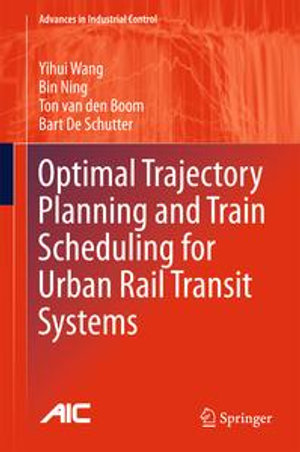
eTEXT
Optimal Trajectory Planning and Train Scheduling for Urban Rail Transit Systems
By: Yihui Wang, Bin Ning, Ton van den Boom, Bart De Schutter
eText | 21 April 2016
At a Glance
eText
$189.00
or
Instant online reading in your Booktopia eTextbook Library *
Read online on
Desktop
Tablet
Mobile
Not downloadable to your eReader or an app
Why choose an eTextbook?
Instant Access *
Purchase and read your book immediately
Read Aloud
Listen and follow along as Bookshelf reads to you
Study Tools
Built-in study tools like highlights and more
* eTextbooks are not downloadable to your eReader or an app and can be accessed via web browsers only. You must be connected to the internet and have no technical issues with your device or browser that could prevent the eTextbook from operating.
ISBN: 9783319308890
ISBN-10: 3319308890
Series: Advances in Industrial Control
Published: 21st April 2016
Format: PDF
Language: English
Publisher: Springer Nature
You Can Find This eBook In
Non-FictionEngineering & TechnologyElectronics & Communications EngineeringElectronics EngineeringAutomatic Control EngineeringEarth Sciences, Geography, Environment, PlanningRegional & Area PlanningUrban & Municipal PlanningCivil EngineeringHighway & Traffic EngineeringEnergy Technology & EngineeringElectrical Engineering
This product is categorised by
- Non-FictionEngineering & TechnologyElectronics & Communications EngineeringElectronics EngineeringAutomatic Control Engineering
- Non-FictionEarth Sciences, Geography, Environment, PlanningRegional & Area PlanningUrban & Municipal Planning
- Non-FictionEngineering & TechnologyCivil EngineeringHighway & Traffic Engineering
- Non-FictionEngineering & TechnologyEnergy Technology & EngineeringElectrical EngineeringPower Generation & Distribution
- Non-FictionSociety & CultureSocial Groups
- Non-FictionReference, Information & Interdisciplinary SubjectsResearch & InformationInformation theoryCybernetics & Systems Theory
- Non-FictionEarth Sciences, Geography, Environment, PlanningGeographyHuman Geography
- Non-FictionLibrary & Info SciencesLibrary & Information Services























